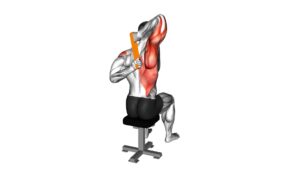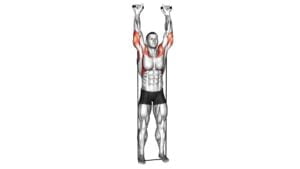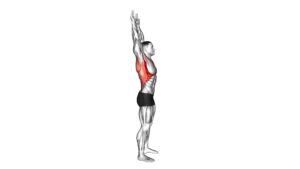Shoulder Stretch Behind the Back – Video Exercise Guide & Tips

Are you looking to improve your shoulder flexibility and relieve tension?
Watch This Exercise Video
In this article, we'll guide you through a shoulder stretch behind the back, providing you with a video exercise guide and tips for proper technique.
Avoid common mistakes, explore variations, and discover how to get the most out of this stretch.
By following our expert advice, you'll be on your way to achieving a more supple and relaxed shoulder area.
Key Takeaways
- Shoulder stretches improve flexibility and range of motion in the shoulder joints and surrounding muscles.
- They can help improve posture by stretching the chest muscles and strengthening the upper back.
- Regular shoulder stretching can reduce the risk of pain and discomfort in the neck, shoulders, and upper back.
- It is important to use proper technique and avoid common mistakes to prevent injury and maximize the benefits of the stretch.
Benefits of the Shoulder Stretch
One benefit of the shoulder stretch behind the back is that it helps improve your flexibility and range of motion. By performing this stretch regularly, you can increase the flexibility of your shoulder joints and the surrounding muscles. This can be particularly beneficial for individuals who engage in activities that require a wide range of shoulder movement, such as athletes or those who work in physically demanding professions.
In addition to improving shoulder flexibility, the shoulder stretch behind the back can also help improve your posture. Many people suffer from rounded shoulders or a hunched back due to poor posture or spending long hours sitting at a desk. This stretch can help counteract these issues by stretching the chest muscles and strengthening the muscles in the upper back. This can lead to a more upright posture, reducing the risk of pain and discomfort in the neck, shoulders, and upper back.
To ensure you get the most out of the shoulder stretch behind the back, it's important to use proper technique.
Proper Technique for the Shoulder Stretch
To perform the shoulder stretch behind the back correctly, follow these steps.
- Start by standing up straight with your feet shoulder-width apart.
- Extend your right arm straight out in front of you, parallel to the floor.
- Bend your right elbow and reach your right hand behind your back, aiming to touch your left shoulder blade.
- Simultaneously, reach your left arm behind your back and try to grab your right hand.
- If you can't reach your hands together, use a towel or strap to bridge the gap between them.
- Once you have a firm grip, gently pull your hands away from each other, feeling a stretch in your shoulders and upper back.
- Hold this position for 20-30 seconds, breathing deeply and maintaining good posture.
- Release the stretch and repeat on the other side.
Incorporating this shoulder stretch into your stretching routine can improve shoulder mobility and help prevent tightness and discomfort in the upper body. Remember to listen to your body, stretch to a comfortable point, and avoid any pain or discomfort.
Common Mistakes to Avoid
To avoid common mistakes, make sure you don't forcefully pull on your hands while performing the shoulder stretch behind the back. This can lead to strain and injury. Instead, focus on gentle and controlled movements to stretch the shoulders effectively.
Here are some tips for improvement:
- Avoid hunching your shoulders forward during the stretch. Keep your spine straight and engage your core to maintain proper alignment.
- Don't rush through the stretch. Take your time and hold the position for at least 30 seconds to allow the muscles to fully relax and stretch.
- Don't push your shoulders beyond their natural range of motion. Listen to your body and stop if you feel any pain or discomfort.
- Avoid rounding your upper back. Keep your chest open and your shoulder blades down and back to maximize the stretch.
- Don't forget to breathe deeply and relax your body throughout the stretch. Tension and stress can hinder the effectiveness of the exercise.
By being mindful of these common mistakes and implementing these tips for improvement, you can ensure that you're performing the shoulder stretch behind the back correctly and safely.
Remember to always consult with a healthcare professional or a qualified fitness instructor if you have any concerns or questions.
Variations of the Shoulder Stretch
Now let's explore different ways you can modify the shoulder stretch to target specific areas and enhance your overall flexibility and mobility.
One variation you can try is the modified shoulder stretch. Instead of clasping your hands behind your back, bring one arm across your chest and use your other hand to gently pull it closer to your body. This modification allows you to focus on stretching one shoulder at a time, making it easier to isolate and target specific areas.
Another variation is the advanced shoulder stretch. To perform this stretch, start by clasping your hands behind your back, just like in the basic shoulder stretch. Then, slowly lift your arms upwards, trying to bring them as close to your head as possible. This advanced version increases the intensity of the stretch, providing a deeper stretch to your shoulder muscles. It requires a greater range of motion and flexibility, so make sure to listen to your body and only go as far as feels comfortable for you.
Remember to maintain proper form and breathe deeply throughout each variation. These modifications can help you tailor the shoulder stretch to your individual needs and goals, allowing you to improve your flexibility and mobility effectively.
Tips for Getting the Most Out of the Stretch
- Maximize your shoulder stretch by incorporating these essential tips.
To get the most out of your shoulder stretch and improve your flexibility, it's important to follow these tips and incorporate them into your stretching routine:
- Warm up: Before attempting any shoulder stretch, make sure to warm up your muscles with a few minutes of light cardio exercise, such as jogging or jumping jacks. This will increase blood flow to the muscles and prepare them for stretching.
- Maintain proper form: When performing the shoulder stretch behind the back, keep your back straight and your shoulders relaxed. Avoid rounding your shoulders or arching your back, as this can lead to strain or injury.
- Gradually increase intensity: Start with a gentle stretch and gradually increase the intensity over time. Never force the stretch or push yourself beyond your limits. Listen to your body and stop if you feel any pain or discomfort.
- Breathe deeply: Remember to breathe deeply and relax during the stretch. Inhale deeply through your nose, and exhale slowly through your mouth. This will help to relax your muscles and increase the effectiveness of the stretch.
- Be consistent: To see improvements in flexibility, it's important to be consistent with your stretching routine. Aim to stretch your shoulders at least three times a week, and gradually increase the duration and intensity of the stretch as your flexibility improves.
Frequently Asked Questions
How Often Should I Perform the Shoulder Stretch Behind the Back?
To improve your shoulder flexibility, it's important to perform the shoulder stretch behind the back regularly. The frequency of this stretch depends on your individual needs and goals.
However, it's generally recommended to do this stretch at least 2-3 times a week. Consistency is key to seeing progress and preventing stiffness.
Remember to listen to your body and adjust the frequency as needed.
Can the Shoulder Stretch Help With Shoulder Impingement?
The shoulder stretch behind the back can be an effective treatment for shoulder impingement. By stretching the muscles and tendons in your shoulder, this exercise can help alleviate pain and improve mobility.
Incorporating shoulder impingement stretches into your regular routine can provide relief and prevent further injury.
Remember to consult with a healthcare professional before starting any new exercise program or if you have any concerns about your shoulder impingement treatment.
Are There Any Modifications for Individuals With Limited Shoulder Mobility?
If you have limited shoulder mobility, there are modifications you can make to the shoulder stretch. It's important to find alternative exercises that work for you and won't cause any pain or discomfort.
By adjusting the position or using props like a towel or strap, you can adapt the stretch to better suit your needs.
Remember to listen to your body and consult with a professional if needed to ensure you're doing the exercises correctly and safely.
Can the Shoulder Stretch Alleviate Upper Back Pain?
The shoulder stretch can indeed alleviate upper back pain. By stretching the shoulder muscles, you can improve flexibility and mobility in the upper body.
To perform the stretch correctly and avoid injury, stand tall and reach one arm behind your back, grasping your opposite hand. Gently pull your hand upward, feeling a stretch in the shoulder and upper back.
Remember to breathe deeply and hold the stretch for 15-30 seconds.
Is It Normal to Feel a Slight Discomfort During the Shoulder Stretch?
Feeling a slight discomfort during the shoulder stretch is normal. It's a sign that your muscles are being stretched and worked.
This exercise has many benefits, including improving flexibility and reducing tension in the shoulders and upper back.
To ensure proper form, stand tall, engage your core, and keep your shoulders relaxed.
Remember to listen to your body and stop if you experience any sharp or intense pain.
Conclusion
Incorporating shoulder stretches into your exercise routine can provide numerous benefits. These include improved flexibility and posture, reduced shoulder pain, and increased range of motion.
By following the proper technique and avoiding common mistakes, you can ensure an effective and safe stretch. It's important to maintain proper form and not push yourself too hard.
Additionally, exploring variations of shoulder stretches can help target different muscles and ensure a well-rounded stretch. Different stretches may have different benefits, so it's worth trying out different ones to find what works best for you.
Implementing tips like holding the stretch for at least 30 seconds can help maximize the benefits. This allows the muscles to fully relax and lengthen.
Make shoulder stretches a regular part of your fitness regimen to enhance your overall shoulder health. Just a few minutes of stretching each day can make a big difference in how your shoulders feel and function.

Author
Years ago, the spark of my life’s passion ignited in my mind the moment I stepped into the local gym for the first time. The inaugural bead of perspiration, the initial endeavor, the very first surge of endorphins, and a sense of pride that washed over me post-workout marked the beginning of my deep-seated interest in strength sports, fitness, and sports nutrition. This very curiosity blossomed rapidly into a profound fascination, propelling me to earn a Master’s degree in Physical Education from the Academy of Physical Education in Krakow, followed by a Sports Manager diploma from the Jagiellonian University. My journey of growth led me to gain more specialized qualifications, such as being a certified personal trainer with a focus on sports dietetics, a lifeguard, and an instructor for wellness and corrective gymnastics. Theoretical knowledge paired seamlessly with practical experience, reinforcing my belief that the transformation of individuals under my guidance was also a reflection of my personal growth. This belief holds true even today. Each day, I strive to push the boundaries and explore new realms. These realms gently elevate me to greater heights. The unique combination of passion for my field and the continuous quest for growth fuels my drive to break new ground.







